“Add a sitemap, and Google will index the whole lot!”
If solely it had been that straightforward. XML sitemaps are a number of the most misunderstood instruments in web site optimization.
But their correct implementation can dramatically affect how search engines like google understand and crawl your web site.
What Is an XML Sitemap?
An XML sitemap acts as your web site’s listing for search engines like google.
Whereas common sitemaps assist human guests navigate your web site, XML sitemaps assist search engines like google perceive your web site’s construction and content material.
Right here’s what a sitemap appears to be like like:
Whenever you add a brand new product web page, publish a weblog submit, or replace your service choices, you want Google (and different engines) to search out and index that content material as shortly as doable.
Index
An index is a computer-generated listing of each web page on a web site that may be accessed by a search engine. It’s created by internet crawlers and utilized by search engines like google to search out pages when customers sort in queries.
What Does a Sitemap Embody?
Your XML sitemap tells Google 4 essential issues about each web page.
1. Location (loc)
That is the URL of the web page, and this must be the complete URL.
https://www.dreamhost.com/merchandise/blue-widget 2. Final Modified Date (lastmod)
A timestamp exhibiting when content material was up to date.
Microsoft’s Bing staff emphasizes that together with the lastmod tag is “essential” for efficient crawling.
Google particularly appears to be like for significant updates.
In response to their documentation, “Google makes use of the
2024-11-30T14:30:00+00:00 Google additionally explains how you can view lastmod dates for web page updates:
“The worth ought to mirror the date and time of the final important replace to the web page. For instance, an replace to the primary content material, the structured knowledge, or hyperlinks on the web page is mostly thought of important; nonetheless, an replace to the copyright date isn’t.”
3. Change Frequency (changefreq)
How typically the content material sometimes updates. Listed here are some instance values:
- In your homepage: “every day” or “at all times”
- For product pages: “weekly”
- For weblog posts: “month-to-month”
- For about pages: “yearly”
- Misc pages: “by no means”
weekly 4. Precedence (precedence)
The relative significance in comparison with different pages. This worth can vary from 0 to 1:
- Homepage: 1.0
- Essential class pages: 0.8
- Product pages: 0.6
- Weblog posts: 0.4
- Archive pages: 0.2
0.8 Does Your Web site Want an XML Sitemap?
We’d extremely suggest you create a sitemap on your web site. Whereas most individuals would recommend having a sitemap solely if in case you have:
- “A very massive web site”
- “Web sites with a big archive”
- “A brand new web site with only a few hyperlinks pointing to it”
- “An internet site which makes use of wealthy media content material”
Google maintains that with correct inner linking, their crawlers ought to discover your content material naturally.
The fact? Most web sites don’t obtain good inner linking buildings. Each trendy web site advantages from having an XML sitemap.
Right here’s why:
The web grows extra complicated every day, making correct web site indexing more and more difficult. You must attempt to present search engines like google with each doable element to assist them discover your content material.
XML sitemaps don’t simply assist with discovery; they make the whole crawling course of extra environment friendly and assist make optimum use of the crawl finances.
What Pages Ought to You Add to the Sitemap?
Your web site comprises two distinct varieties of pages.
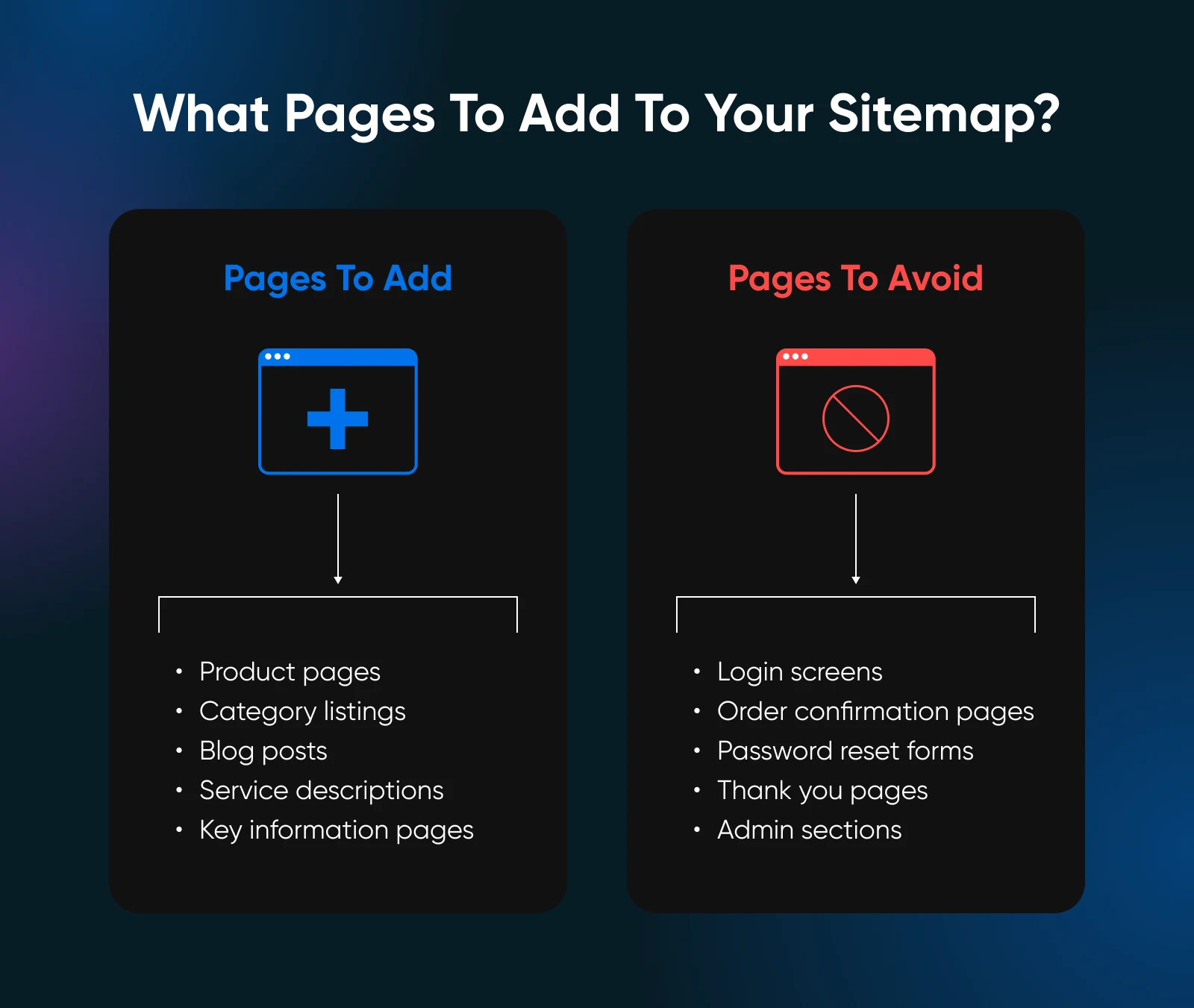

1. Search touchdown pages
Pages customers ought to discover by means of search:
- Product pages
- Class listings
- Weblog posts
- Service descriptions
- Key info pages
2. Utility pages
Pages that serve a perform however shouldn’t seem in search:
- Login screens
- Order affirmation pages
- Password reset types
- Thanks pages
- Admin sections
Your XML sitemap ought to solely embrace the search touchdown pages. Together with utility pages dilutes your web site’s perceived high quality and wastes worthwhile crawl sources of the search engine.
How To Create XML Sitemaps?
You will have a number of choices for creating XML sitemaps, starting from handbook creation to automated options.
Let’s begin with the only approaches and transfer to extra superior strategies.
Manually Making a Sitemap
For small static web sites, you may manually create your XML sitemap utilizing any textual content editor.
Create a brand new file referred to as “sitemap.xml” and use this fundamental construction:
https://www.yourwebsite.com
2024-01-01
Add a brand new
Automated Options for WordPress Websites
If you happen to run a WordPress web site, you have already got a number of highly effective website positioning instruments:
- All in One website positioning: Presents complete sitemap options, together with customized submit sort help and automated precedence calculation based mostly on content material age and kind. Entry your sitemap at “yourdomain.com/sitemap.xml.”
- Yoast website positioning: The preferred alternative for WordPress sitemap era. After set up, your sitemap is generated routinely at “yourdomain.com/sitemap_index.xml.” You may management which content material varieties seem in your sitemap by means of the plugin’s settings.
- Rank Math: Presents related performance to Yoast however consists of extra options like Google Information sitemaps and video sitemaps. Your sitemap shall be obtainable at “yourdomain.com/sitemap.xml.”
- WordPress Core: Since model 5.5, WordPress consists of fundamental sitemap performance. Nonetheless, most website positioning professionals want devoted plugins for his or her extra management and options.
Options for Non-WordPress Web sites
If you happen to used one other platform to construct your web site, they probably have a built-in resolution for creating these sitemaps.
If you happen to don’t use a platform and have constructed a totally customized web site, you’ll must depend on an exterior sitemap generator and add the auto-generated sitemap to your internet server at common intervals.
Listed here are a number of good sitemap turbines:
- XML-Sitemaps.com: Add your web site construction or let it crawl your web site to generate a sitemap.
- Screaming Frog: Crawls your web site and creates a sitemap based mostly in your specs.
- Sitebulb Web site Crawler: Streamlines XML sitemap creation with highly effective insights to optimize web site construction.
How To Submit Your Sitemap to Google
Producing your sitemap marks solely the start of the method. It’s worthwhile to inform Google the place to search out it.
Whereas Google may ultimately uncover your sitemap by means of your robots.txt file, direct submission by means of Google Search Console quickens the method considerably.
Earlier than You Submit
First, guarantee your sitemap really works. A damaged sitemap wastes Google’s time and yours. Go to “yourdomain.com/sitemap.xml” in your browser. You must see a correctly formatted XML file, not an error web page.
Professional Tip: If you happen to see garbled textual content, don’t fear — that’s regular. XML recordsdata typically look messy in browsers. The essential half is you can see your URLs listed.
Submitting By means of Google Search Console
- Log into Google Search Console.
- Choose your web site property.
- Navigate to the Sitemaps part from the left sidebar.
- Enter your sitemap URL within the “Add a brand new sitemap” subject and click on SUBMIT.
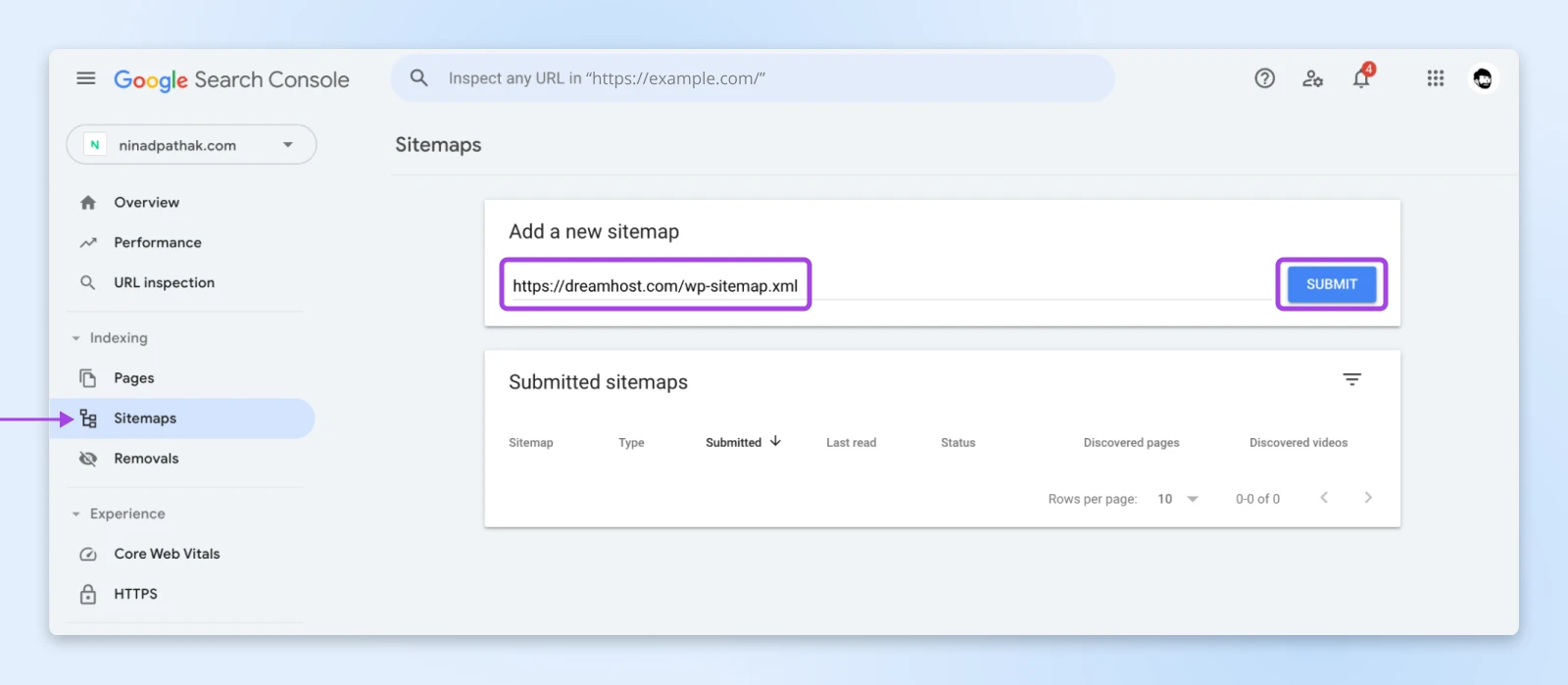

Relying on if in case you have a area property or URL prefix, you’ll both must enter the complete URL or simply the half after your area.
As an example, within the above picture, you see that we entered the complete URL because it’s a website property.
Right here’s what it appears to be like like for a URL prefix property — right here, you solely must enter the half after the area identify:


You’ll sometimes retailer the XML sitemap as “https://yourdomain.com/sitemap.xml” or “sitemap_index.xml.”
Google will instantly verify your sitemap for fundamental errors. You’ll see one in every of these standing indicators:
- Success: Google can learn your sitemap accurately.
- Couldn’t fetch: Google couldn’t entry your sitemap.
- Couldn’t learn: Google discovered your sitemap however couldn’t course of it.
Understanding the Sitemap Report
As soon as submitted, Google Search Console exhibits you:
- What number of URLs you’ve submitted.
- What number of URLs Google has really listed.
- The final time Google learn your sitemap.
Necessary: Don’t panic if the variety of listed URLs differs from submitted URLs! Google doesn’t index pages simply because they’re in your sitemap — bear in mind, it’s a suggestion, not a command.
A number of Sitemaps
For bigger web sites, you might need a number of sitemaps:
- Product sitemap
- Weblog submit sitemap
- Class sitemap
- Picture sitemap
Submit every one individually to assist Google perceive your web site construction higher and to make monitoring indexation points simpler.
Submitting Your Sitemap to Bing
Whereas Google dominates the search panorama, good website positioning professionals know the worth of diversifying their search engine presence. Bing captures a good portion of search visitors, particularly in sure demographics and areas. Plus, their webmaster instruments typically present distinctive insights you gained’t discover elsewhere.
You’ll discover that whenever you click on on “Add new web site”, it provides you two selections – “Import your websites from GSC,” or “Add your web site manually.”
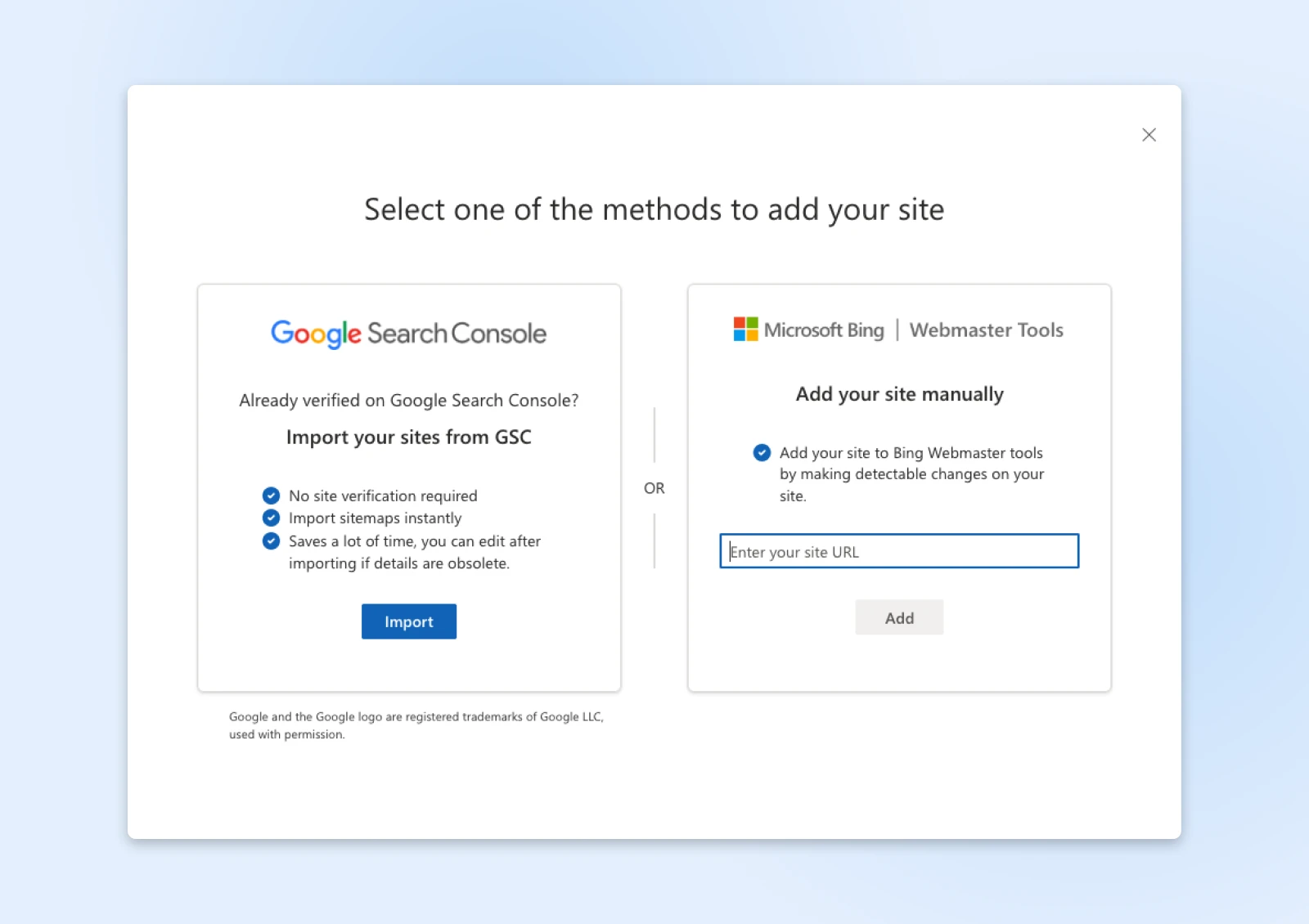

Importing Web sites From Google Search Console
Already verified your web site in Google Search Console? You’re in luck! Bing gives a streamlined import course of that may prevent worthwhile setup time.
- Head to Bing Webmaster Instruments.
- Click on Import from Google Search Console.
- Comply with the authentication steps.
- Watch as your web site particulars, together with sitemaps, switch routinely!
Guide Website and Sitemap Submission
For these beginning recent or preferring handbook management, Bing’s direct submission course of proves easy:
- Navigate to Bing Webmaster Instruments.
- Select Add your web site manually.
- Enter your web site’s URL.
- Confirm possession by means of your most popular technique:
- Add an XML file.
- Add a meta tag.
- Add a CNAME report.
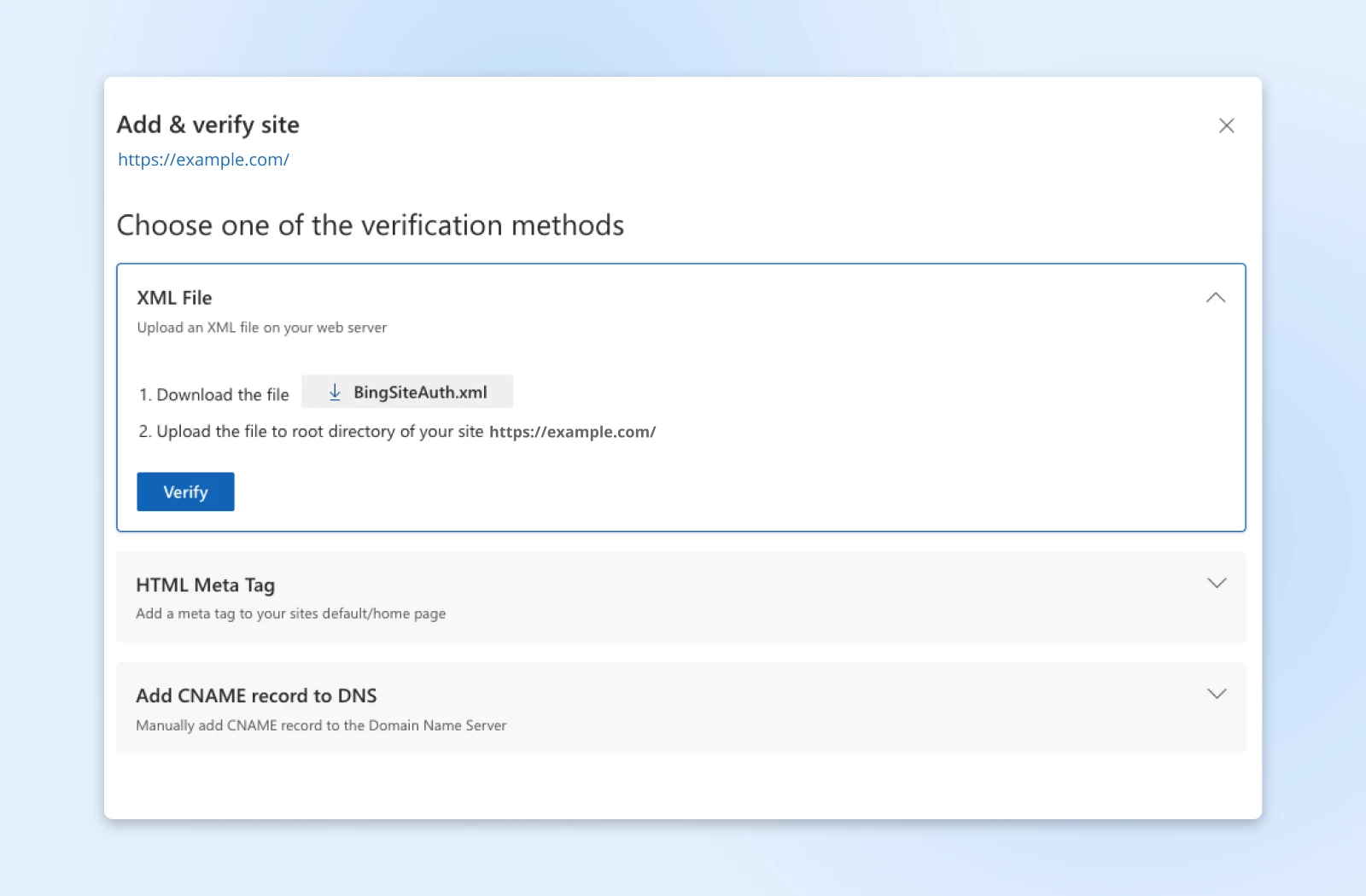

Head to Sitemaps from the left sidebar after which click on Submit sitemap.
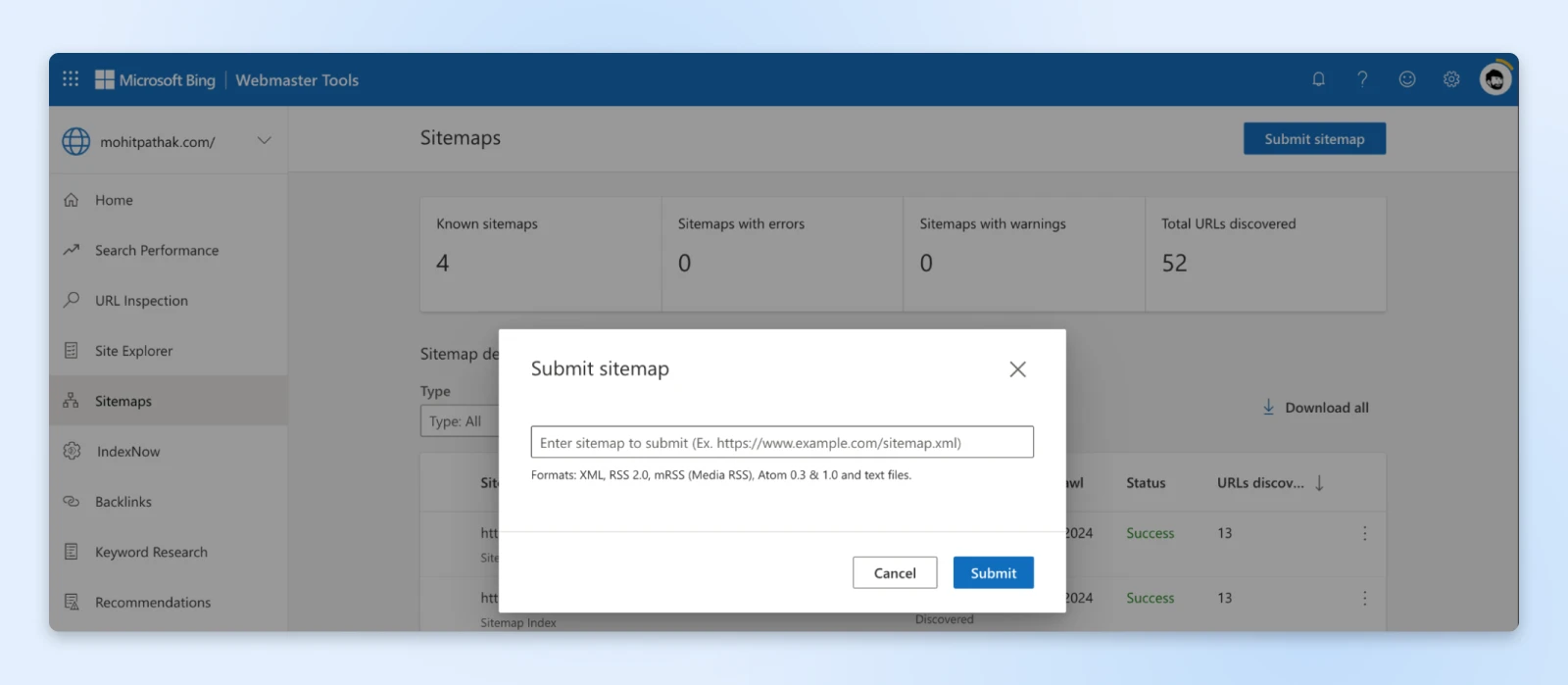

Lastly, add the complete sitemap XML and click on Submit.
Frequent Submission Errors
For Bing Webmaster instruments, you simply see the phrase “Error” or “Success,” and clicking on the row provides you with extra particulars concerning the error.
For Google Search Console, nonetheless, you’ll see errors proper there.
If you happen to get “Couldn’t fetch,” verify whether or not:
- Your sitemap URL is appropriate.
- Your web site is accessible.
- Your robots.txt file isn’t blocking the sitemap.
If you happen to get “Couldn’t learn,” confirm that:
- Your XML syntax is legitimate.
- You’re utilizing the right XML schema.
- The file isn’t compressed or corrupted.
After Submission
Monitor your sitemap standing repeatedly. Take note of:
- Sharp drops in listed pages.
- Rising gaps between submitted and listed URLs.
- Warning messages within the sitemap report.
Bear in mind: Submitting your sitemap to Google represents an ongoing course of, not a one-time process. Hold monitoring and updating as your web site grows and modifications.
Frequent Myths About XML Sitemaps
Let’s clear up some persistent misconceptions about XML sitemaps and their position in search engine marketing.
Fable 1: Sitemaps Guarantee Indexing on Google
Many web site homeowners imagine submitting a sitemap means automated indexing. However including pages to your sitemap doesn’t assure Google will embrace them in search outcomes.
Google’s algorithm decides what to index based mostly on many components, together with web page high quality, uniqueness, and general worth to customers. Your sitemap solely serves as a mild suggestion to Google saying, “Hey, these pages are price your consideration.”
Very like including a web page to your major navigation menu, it’s one in every of many indicators Google makes use of to grasp your web site’s construction and content material hierarchy.
Fable 2: Each Web page Ought to Be in Your Sitemap
Typically, web site homeowners add their total web site construction into their sitemap, considering extra is healthier.
Your sitemap ought to solely embrace pages you genuinely need customers to search out by means of search. Attempt to keep its measurement below 50,000 URLs and maintain file sizes under 50MB uncompressed.
UTF-8 encoding additionally helps search engines like google learn your sitemap accurately, whereas correct XML formatting prevents parsing errors that would derail your efforts.
The factor is, should you begin together with login pages, thanks pages, or duplicate content material; it signifies to Google that you simply don’t perceive what content material really issues to customers.
Consider your sitemap like a restaurant menu. You wouldn’t listing the kitchen, storage room, or employees lavatory — you solely present what clients might order.
Fable 3: Replace Frequency Doesn’t Matter
Sitemaps live paperwork.
Even when manually updating them looks like a chore, that you must use some type of automation to auto-update the sitemap with any newly revealed pages that matter to you.
Outdated sitemaps containing deleted pages or lacking new content material can really hurt your web site’s crawling effectivity. Google’s crawlers waste worthwhile time checking non-existent pages whereas probably lacking your recent content material.
Your sitemap ought to mirror your web site’s present state, similar to a map wants to point out present roads and landmarks to be helpful.
Fable 4: All XML Tags Are Equally Necessary
Many spend time perfecting their changefreq and precedence values, considering they considerably affect Google’s conduct.
The URL location (loc) and final modified date (lastmod) are the one two required parts of your XML sitemap. The opposite tags present context however don’t straight influence crawling or indexing selections.
So, focus your vitality on sustaining correct URLs and last-modified dates, and you’ll fully skip worrying about precedence and alter frequency.
Ultimate Ideas
Your XML sitemap tells a narrative about your web site’s group and priorities. So, make it well worth the search engine’s time to learn and course of it.
And right here’s one factor to remove: high quality beats amount right here. A centered sitemap of your finest pages outperforms a cluttered listing of the whole lot you personal.
Need to nail the technical basis of your web site?
Dreamhost’s managed WordPress internet hosting handles the complexities when you deal with what issues — creating content material your viewers loves.
This web page comprises affiliate hyperlinks. This implies we might earn a fee if you buy providers by means of our hyperlink with none further value to you.
Did you take pleasure in this text?

